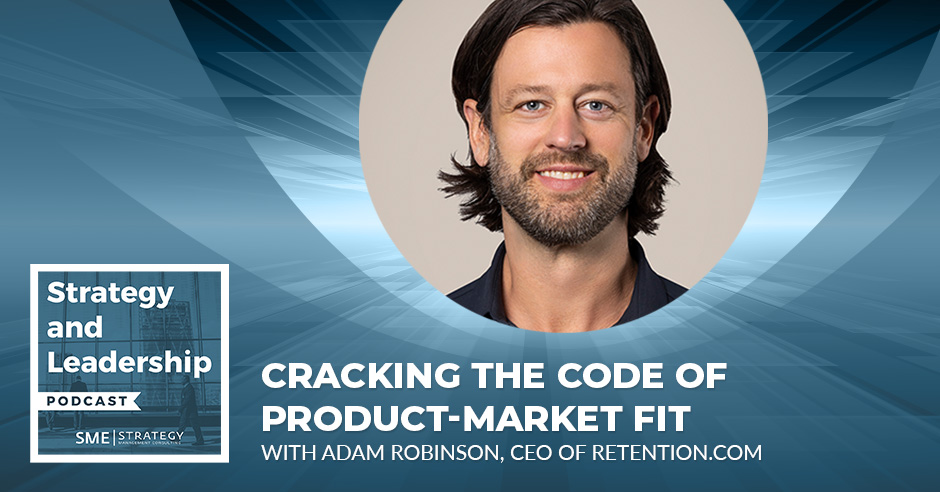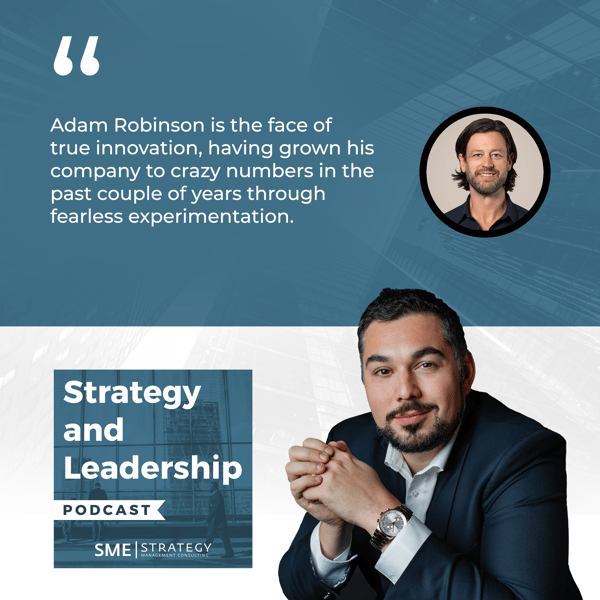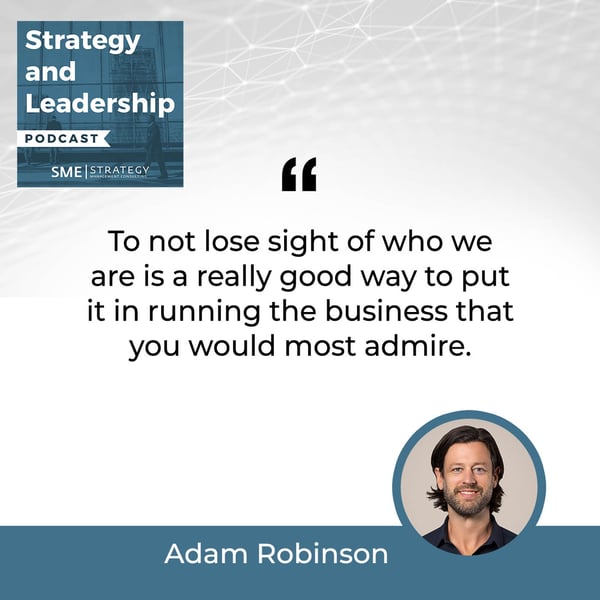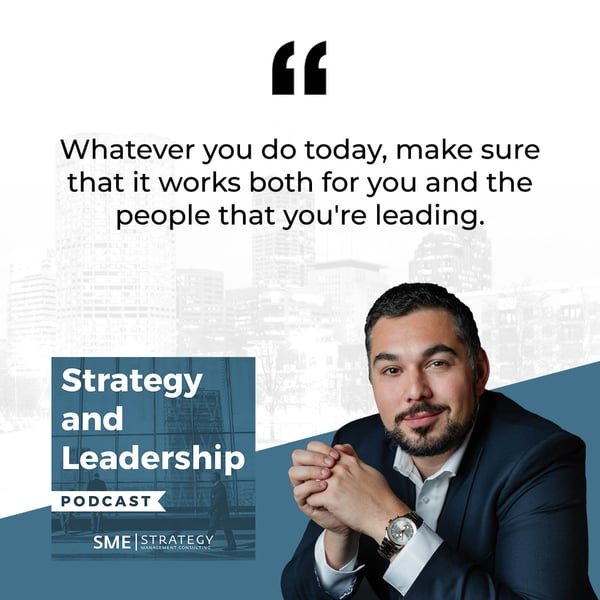Cracking The Code Of Product-Market Fit With Adam Robinson, CEO Of Retention.com

True innovation is about building what customers can't wait to have, not just what they need. In this riveting episode, get ready to dive into the world of exponential growth, daring experiments, and the art of bouncing back from setbacks. Our guest, Adam Robinson, the visionary CEO and founder of Retention.com, takes us on an inspiring journey through his roller-coaster ride of scaling businesses and shaping resilient teams. Adam introduces his unique "face-lighting-up" barometer approach to identifying game-changing products. He also dives into the evolving landscape of marketing and customer attraction strategies and shares how to foster a culture of balanced experimentation. He emphasizes how true innovation ignites not just interest, but excitement. Tune in as Adam shares what it takes to lead with vision, resilience, and a dash of fearless experimentation.
Listen on Spotify: https://open.spotify.com/episode/46kYs6B5uveniD8FWnl5Bt?si=4935b5ca6b38440d
Listen on Apple Podcasts: https://podcasts.apple.com/ca/podcast/cracking-the-code-of-product-market-fit-with/id1202449526?i=1000628743145
---
Watch the episode here
Listen to the podcast here
Cracking The Code Of Product-Market Fit With Adam Robinson, CEO Of Retention.com
Our sponsor for this show is Affinity Staffing Group. If you're looking for some staffing support and get some great Canadian talent, visit Affinity-Group.ca/SME. One of their team members will set you up for a conversation. I get to speak with Adam Robinson who is the CEO and Founder of Retention.com. Adam, what's happening?
Every day is a new adventure.
I was looking at your LinkedIn and all the stuff that you've been up to and that you're doing now. You're growing Retention.com over the past couple of years to crazy numbers. Why don't you tell our audiences a little bit about you? You're calling from Austin.
I live in Austin, Texas. We will start there. I had my first child. That's a personal bit of information. It's so fantastic. I'm on my second company. It's called Retention.com. We sell into the Shopify ecosystem and help people solve problems related to their onsite identity. If people hit the store, and they don't do anything, how are you supposed to communicate with them again?
Other problems are popping up with privacy changes at Apple where even companies like Facebook, TikTok, and these email providers can't track people longer than seven days, which is a huge problem. We can track people for 6 months to 12 months. This is the type of thing that we do. I'm building public effort. We're at $20 million ARR. We bootstrapped team sizes around 50. Those two things are what I do. I don't do anything else.
A $20 million ARR for those of you at home is a pretty significant deal, especially about four years in. I wanted to chat with you because you're a founder. Growing from zero to 50 or 20 depending on how you look at things is cool. You've had a lot of cool experiences. The internet marketing space or overall internet space has evolved over the years.

What I find interesting as a founder/marketer by trade is how the world of marketing is evolving fast over the past couple of years. Largely driven by privacy, the remote post-COVID world gave it a shot in the arm, and then everything that's going on with being able to attract and target consumers. One of the things that I read was you do well as a company because you understand the product-market fit. My first question to you is this. What is your overall approach or mantra to customer attraction and customer retention? We will go from there.
This is a strange one but my approach is that every situation is super different, and what worked last time and what works this time is going to be different. Experience is good inspiration, and other people's experience is good inspiration but it's not prescription. This is a very caveman way to approach it but we're working on a new product. If I can walk up to somebody who falls in the ideal customer profile and tell them about it, and their face does not immediately light up, or if I get that signal over and over again, I'm not building it. If I see their face light up over and over again, and they go even farther and they're like, "When can I get that?" I'm trying to build that as quickly as possible.
That's my personal barometer for the early stage of product-market fit. You need to deliver what you're talking about, and it needs to produce enough ongoing value that people keep paying for it. My philosophy is the one-sentence description has to stop your ideal customer profile in its tracks. It has to be something new, different, and way better than they need. The more acute the pain, the better.
I get that. It's neat. Let's call it product-market fit. If you're looking in the marketing space, that's critical but all leaders have a version of product-market fit that they're looking for. It's an initiative that they're working on. It's something that they're trying to get across the line. If the person's face doesn't emote, then what you said hasn't landed. There is no inspiration. It hasn't brought life into the person.
Whether you're trying to sell something, whether you're trying to push a project along, or whether you're trying to get buy-in for your strategy, making sure that whatever you're saying, and I love that one-sentence problem statement, has to hit them is critical. The other thing that was important for our audiences to remember is that what worked before won't necessarily work again.
I'm going to go as far as to say it probably won't.
I'll ask you about that. As a leader or as somebody who's been in the seat for a while, you're like, "I've gotten used to it." You get into a flow. You've been there and done that. We have some leaders that we talk to who are arguably less coachable, and they say, "I know everything. I've seen everything. I know how this is going to go," versus approaching it with a beginner's mindset. You took it as far as it probably won't work again. Give me your rationale or your thought behind that. How do you employ that as a CEO, not just as a person doing the work? How do you drive that forward with your team?
My COO is very experienced. He's worked with twenty B2B companies at the executive level trying to get them to grow. One of them was ZoomInfo. One of them was Apollo.io. He was the Co-CEO of Apollo.io. He worked in ZoomInfo for eight years. He says that two kinds of people generally are capable of creating something truly exponential. It's usually young people or older entrepreneurs who have had this mindset their whole career and have been successful their whole career. He's like, "A lot of people get stuck in the middle." If there's a 30-year-old that has made $10 million some way, they're not many times thinking in a way and taking the type of crazy risks that would lead to a truly exponential outcome.
Two kinds of people generally are capable of creating something truly exponential: very young people or older entrepreneurs who have had this mindset their whole career and been successful.
I always try to have 4 or 5 insane experiments going on that could be 1000X. That's how we discovered all of the stuff we work on now, and a lot of it doesn't work. Almost all of it doesn't work but it's continuing to throw spaghetti against the wall. Having that mindset that the world is changing so fast, your ability to do anything on any platform that you would reach anyone is so different now than it was before. That is the mindset that it takes to be successful at anything these days.
Let's say there was a dichotomic world where there is the incremental and then the transformational. You and your business have grown so quickly in the tech internet world where things are scalable much easier. That's a generalization that's probably false. Is that what you say? It's like, "You have to come in here. We're looking for not home runs only." How do you foster culture? How do you foster that thinking? How do you balance the big failures that are required to predicate big successes with the operational wins that need to happen every day to keep the lights on?
There are two parts of the business. There's the operational part that's our business, and then there's the part of the business, which is the next S-curve. You bang your head against the wall, and then all of a sudden, it's going straight up. It peters off at some point when you reach your TAM or cross the chasm, or how you want to say it. You need to be working on your next S-curve as the first one starts happening. In my opinion, that's a bunch of different experiments.
For a tech company, it's all about products. After you have the product, it's go-to-market but I'm super involved in these early-stage experiments. I'm the one that comes up with them all. There's part of the org that's doing that, and then everybody else is doing the, "Let's make the most of this business that we can." That's how we do it. It's going to be different in every shop.
The thing that I hear is that sometimes visionary CEOs can be the bane of certain people's existences because you have that balance between the COO, for example, who's like, "We need to do it this week." There's the CEO who is pushing the boundaries and moving everything forward. In certain organizations, there is no balance, and it frustrates the hell out of people. In other organizations, it sounds like yours.
You figured out a way to not separate those two parts of the businesses but have clear delineation and equilibrium between the day-to-day work and then the big-picture strategy, "How are we going to get that next piece of growth?" It sounds like you've been able to do that successfully. What did you do? Did you set out the roles and responsibilities clearly? Did you say, "I want to be here, and I need somebody to do that?" What were the steps that you took so that our leaders could process better?
The COO also thinks this way. He's very involved in this wildly experimental part of our business but there's a clear delineation. Aside from us two, nobody is working on both parts of it. We have the entire team that's working on the now part, and we have other teams that are working on the other parts.
Nobody's working on really both parts of an experiment. Have an entire team that's working on the today part and have other teams work on the other parts.
That's neat because where I've seen teams struggle is where they're expected to do both, or they have such a broad set of activities that it's hard to think in both ways. It's hard to do tasks. You're expecting all things from all people but that's not realistic. It's cool to see that you've separated that. Let's take a step back. You're at Retention.com. You're kicking butts. You had an exit in one of your businesses.
If I look at your presumably twenty-year career, what are some of those lessons that you learned either the hard way or some stuff that stuck with you that has informed your leadership of people, how you've built teams, and how you've collaborated? Are there any lessons learned that you're like, "I don't want to do that again." I'm happy to hear those as well.
I've learned so many lessons. I don't even know where to start. I was running super lean until October 2022, and then it appeared as though we honed in on an ICP. There was a land grab to be had, and we needed to hire a lot of go-to-market people very quickly. We did it way too fast. I was desperate. I lost the plot of growing responsibly and being frugal. All of these things that I consider to be important were bootstrapped. We didn't have a big bank account balance because we were paying dividends. There was only so much damage that I could do with that mentality but people who sell what we sell and who we sell to have experienced a tremendous slowdown from the first quarter when I was doing all this. I hired a bunch of people, and it stopped.
In hindsight, it would have been nice to go a lot slower. The sense of desperation that I had turned out to be as it always is, the FOMO feeling. You make bad decisions when you have a FOMO feeling. I learned a lesson to not lose sight of who we are and run the business that I would most admire. It doesn't make sense any other way. It's my business. Why would I run it in a way that was anything short of something that I would look at and be like, "That's a great business?" That was the most recent one.

Thank you. Let's look at that one. It's obvious looking backward. What I see that's tough is companies that have private equity. Private equity invested companies have that external pressure. The board is putting pressure on them, and they're like, "You have to get the juice." I don't know if it was ego. I don't think it was but it could have been something. You have that driver, "I have to win. I want to win," or that mentality, whereas going through it, you're looking back, "That was probably not the right thing to do," but you can only learn that lesson looking backward.
Some version of it was the right thing to do. The fury and desperation with which we did it were not helpful. It takes undoing, and we're undoing it.
You learn. I'm a believer. The root cause of this failure or learning was probably the same thing that made you successful. You've probably done a similar-ish thing in the past, and a couple of them hit. The only way that you can get to that level of success is because you're willing to take that failure. This time, it wasn't right. There's going to be another time when you're like, "I'm the smartest guy in the world. Look at me. I executed this perfectly." Sometimes it doesn't work. My friend and financial advisor say, "It's a speeding ticket. You went fast. This time, you got busted." At other times, you're going to go and speed up your business, and it's going to work out great.
That metaphor makes me feel better about being an idiot.
It's a prerequisite. I'll turn the knife a little bit on that one. Given that you did that, and every leader has more mistakes than they can remember, how did you address that with the team? How did you say, "I made a mistake. I did something that didn't work." That's probably a better way to look at it. How did you course-correct internally? How did you have that conversation? How did you get your team back on track?
It was pretty obvious to everybody that we had these euphoric numbers in the first quarter, and it stopped in the second quarter. We had to get a little bit smaller, and we did. I fairly clearly articulated something similar to what I said to you, "I view a great business as a highly capital-efficient, highly profitable, and solidly growing enterprise. We are in control of that.
Everybody should want to work for a company that's run as a tight ship. We're going to make more and spend less every month for the rest of the year. Here are the profitability goals." That was my way of being like, "I take the responsibility. I was the main actor, encouraging this, making it all happen, and running everything. We're going to get back to who we were."
You can't argue the fundamentals of business. What's cool about it is you say, "What are the fundamentals?" You let the team know and talk about it. You owned it. There are so many organizations. You look at all the rifts that happened because they grew too fast. You were not the only person who tried to do that because you saw the possibility and said, "Let's do that."
Sometimes it doesn't work but it's a cool and great lesson for all leaders to say, "There are things that don't work sometimes." You own it, get back to the fundamentals, and grow into $20 million in 4 years. The ARR is pretty awesome. Kudos to you. It sounds like you have a great team. As we finish up, is there anything that you want our readers to know either about Retention.com, how to be a leader that learns, or anything else that you want to share or plug before we finish up?
If you happen to be a Shopify founder, check us out at Retention.com. For everybody else, keep throwing spaghetti against the wall. That's my advice.
Just keep throwing spaghetti against the wall.
Where can people connect with you? Where can they learn more about the work that you're doing and all the podcasts you do?
I do a lot of stuff on LinkedIn. My LinkedIn handle is @RetentionAdam. My Twitter handle is @RetentionAdam. Between those two, you will get more content than you ever dreamed of.
If you want more of Retention Adam, check him out online.
I'm making a docuseries called Billion Dollar Challenge. There's a ten-minute episode every week about being in the middle of all this furious scaling.
What do you want to do? That's the last question, and then we will finish up.
Media around companies is changing. The people who buy our products are business owners. I had never been wildly transparent, "This is what it's like being in the middle of this show and trying to go for it." I hadn't seen a lot of stuff like that. I found a girl who's good at putting this stuff together. It's super high-quality. What they're doing is incredible. That's a cool thing. It's on my social profiles. You can click on it and binge three ten-minute episodes. There are 7 or 8 now.
I'm being pretty honest about what it's like, what sucks, and what's cool. After 30 minutes, it's like, "I'm on that guy's team. That's the goal. That's why." You never know who is going to binge it and be like, "I'm on that guy's team," and what effect that might have someday. I did it for an inbound trust-building engine that was very different than what I perceived anyone doing in anything adjacent to who we're selling to.
If you look at what Drive to Survive did to F1, Adam's docuseries will do to Retention.com. As we look at the future of brands, it's that connection with the individual person. We could do a whole other episode on individual CEOs, brand building, Kylie Jenner, and all the rest. Adam Robinson, thank you so much for being here. It has been a blast. I had so much fun. I learned a lot. I wish you all the best moving forward with all the stuff that you're kicking butt on.
Thank you very much. It's great to be here, Anthony.
It's my pleasure. Thanks for joining, Adam. As you think of your leadership, there's that balance of throwing spaghetti on the wall and trying to figure out what fits and what doesn't but then also being able to own that and drive that forward with your team in an effective way. Whatever you do, make sure that it works both for you and the people that you're leading. Thank you, again, Adam, the CEO and Founder of Retention.com. Thank you, Affinity Staffing Group. You're the best. I hope everybody has a great day. I'll see you next time.

Important Links
- Affinity-Group.ca/SME
- Retention.com
- ZoomInfo
- Apollo.io
- @RetentionAdam - LinkedIn
- @RetentionAdam – Twitter
- Billion Dollar Challenge - LinkedIn
- Danielle@Lemonpie.fm
About Adam Robinson

Adam Robinson has never been afraid to shake things up. He’s a serial entrepreneur, a wizard of high-ROI marketing strategies, and a heterodox thought leader in the realm of digital privacy. At the helm of his MarTech startup Retention.com, he’s melding his iconoclastic style with groundbreaking identity resolution technology to solve the #1 problem marketers and eCommerce brands face today: growing, engaging, and reactivating their first-party database.


